warning light Mercury Mariner Hybrid 2008 s Owner's Guide
[x] Cancel search | Manufacturer: MERCURY, Model Year: 2008, Model line: Mariner Hybrid, Model: Mercury Mariner Hybrid 2008Pages: 320, PDF Size: 2.5 MB
Page 171 of 320
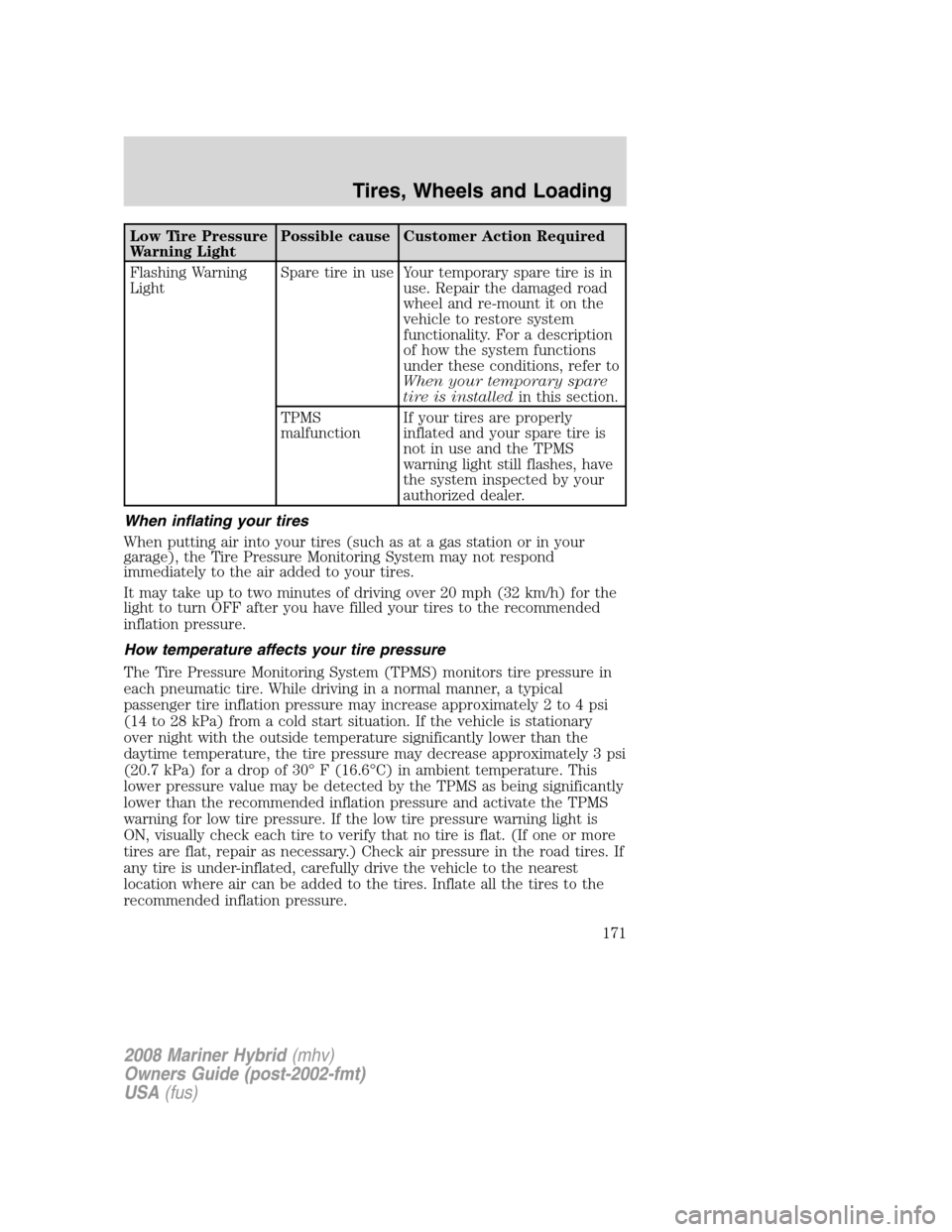
Low Tire Pressure
Warning LightPossible cause Customer Action Required
Flashing Warning
LightSpare tire in use Your temporary spare tire is in
use. Repair the damaged road
wheel and re-mount it on the
vehicle to restore system
functionality. For a description
of how the system functions
under these conditions, refer to
When your temporary spare
tire is installedin this section.
TPMS
malfunctionIf your tires are properly
inflated and your spare tire is
not in use and the TPMS
warning light still flashes, have
the system inspected by your
authorized dealer.
When inflating your tires
When putting air into your tires (such as at a gas station or in your
garage), the Tire Pressure Monitoring System may not respond
immediately to the air added to your tires.
It may take up to two minutes of driving over 20 mph (32 km/h) for the
light to turn OFF after you have filled your tires to the recommended
inflation pressure.
How temperature affects your tire pressure
The Tire Pressure Monitoring System (TPMS) monitors tire pressure in
each pneumatic tire. While driving in a normal manner, a typical
passenger tire inflation pressure may increase approximately 2 to 4 psi
(14 to 28 kPa) from a cold start situation. If the vehicle is stationary
over night with the outside temperature significantly lower than the
daytime temperature, the tire pressure may decrease approximately 3 psi
(20.7 kPa) for a drop of 30° F (16.6°C) in ambient temperature. This
lower pressure value may be detected by the TPMS as being significantly
lower than the recommended inflation pressure and activate the TPMS
warning for low tire pressure. If the low tire pressure warning light is
ON, visually check each tire to verify that no tire is flat. (If one or more
tires are flat, repair as necessary.) Check air pressure in the road tires. If
any tire is under-inflated, carefully drive the vehicle to the nearest
location where air can be added to the tires. Inflate all the tires to the
recommended inflation pressure.
2008 Mariner Hybrid(mhv)
Owners Guide (post-2002-fmt)
USA(fus)
Tires, Wheels and Loading
171
Page 184 of 320
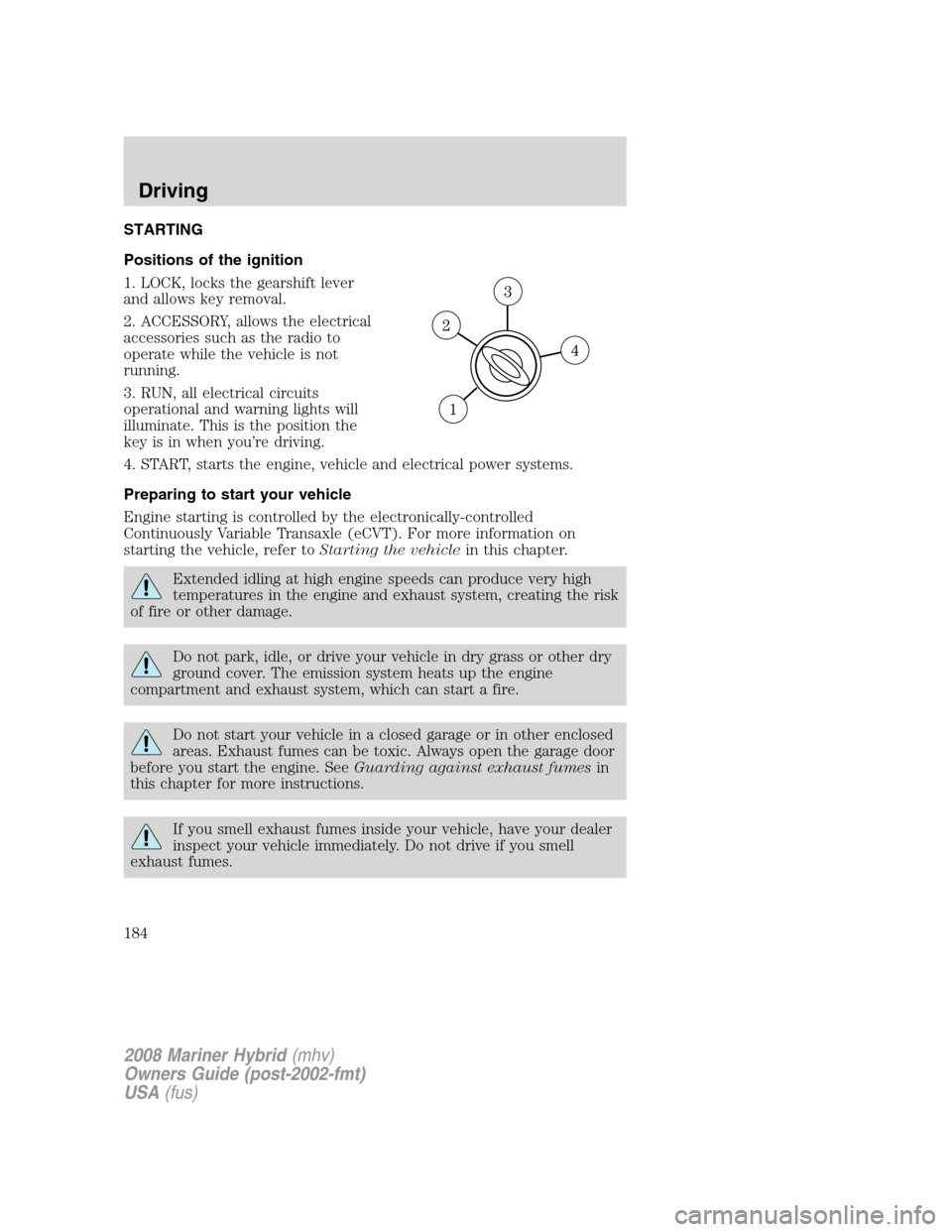
STARTING
Positions of the ignition
1. LOCK, locks the gearshift lever
and allows key removal.
2. ACCESSORY, allows the electrical
accessories such as the radio to
operate while the vehicle is not
running.
3. RUN, all electrical circuits
operational and warning lights will
illuminate. This is the position the
key is in when you’re driving.
4. START, starts the engine, vehicle and electrical power systems.
Preparing to start your vehicle
Engine starting is controlled by the electronically-controlled
Continuously Variable Transaxle (eCVT). For more information on
starting the vehicle, refer toStarting the vehiclein this chapter.
Extended idling at high engine speeds can produce very high
temperatures in the engine and exhaust system, creating the risk
of fire or other damage.
Do not park, idle, or drive your vehicle in dry grass or other dry
ground cover. The emission system heats up the engine
compartment and exhaust system, which can start a fire.
Do not start your vehicle in a closed garage or in other enclosed
areas. Exhaust fumes can be toxic. Always open the garage door
before you start the engine. SeeGuarding against exhaust fumesin
this chapter for more instructions.
If you smell exhaust fumes inside your vehicle, have your dealer
inspect your vehicle immediately. Do not drive if you smell
exhaust fumes.
2008 Mariner Hybrid(mhv)
Owners Guide (post-2002-fmt)
USA(fus)
Driving
184
Page 186 of 320
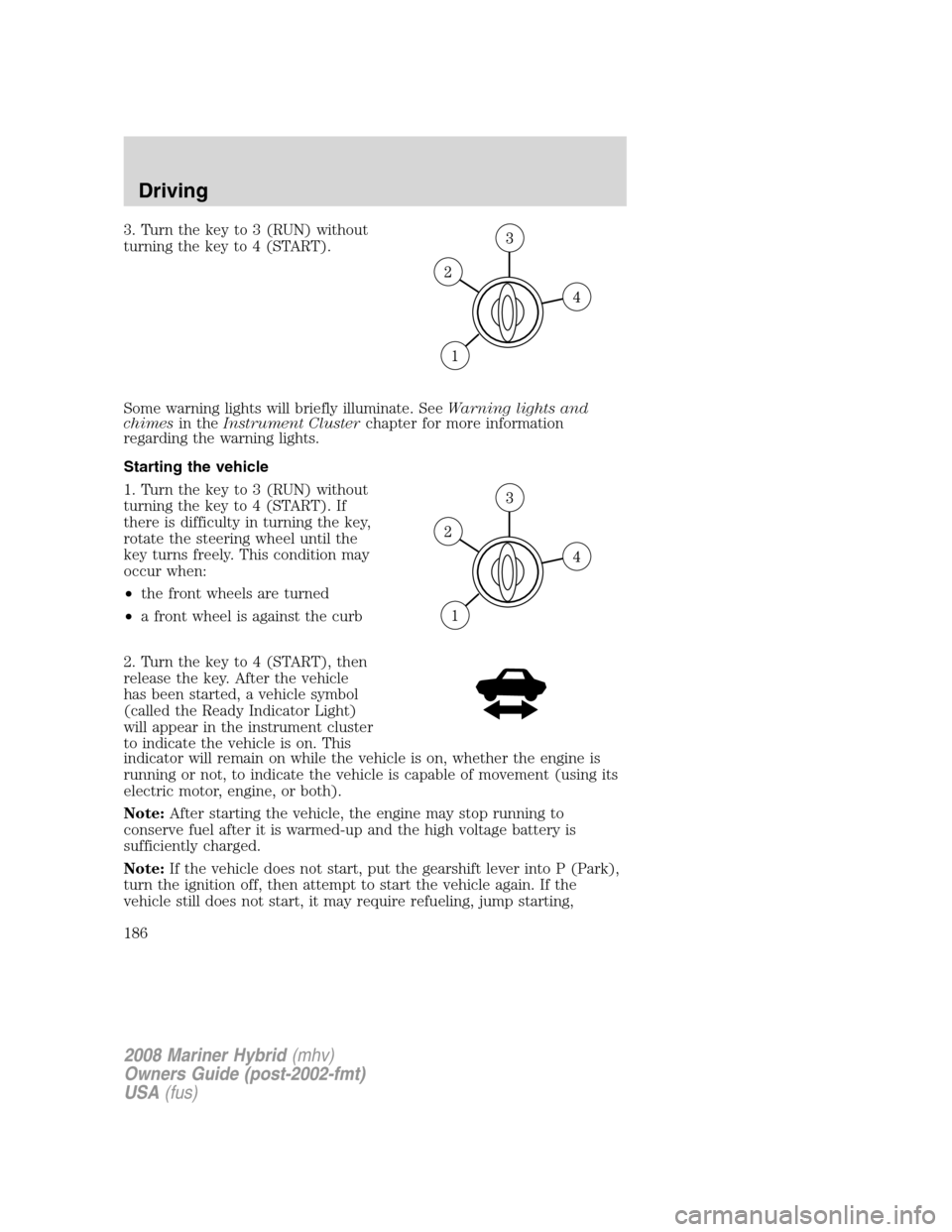
3. Turn the key to 3 (RUN) without
turning the key to 4 (START).
Some warning lights will briefly illuminate. SeeWarning lights and
chimesin theInstrument Clusterchapter for more information
regarding the warning lights.
Starting the vehicle
1. Turn the key to 3 (RUN) without
turning the key to 4 (START). If
there is difficulty in turning the key,
rotate the steering wheel until the
key turns freely. This condition may
occur when:
•the front wheels are turned
•a front wheel is against the curb
2. Turn the key to 4 (START), then
release the key. After the vehicle
has been started, a vehicle symbol
(called the Ready Indicator Light)
will appear in the instrument cluster
to indicate the vehicle is on. This
indicator will remain on while the vehicle is on, whether the engine is
running or not, to indicate the vehicle is capable of movement (using its
electric motor, engine, or both).
Note:After starting the vehicle, the engine may stop running to
conserve fuel after it is warmed-up and the high voltage battery is
sufficiently charged.
Note:If the vehicle does not start, put the gearshift lever into P (Park),
turn the ignition off, then attempt to start the vehicle again. If the
vehicle still does not start, it may require refueling, jump starting,
2008 Mariner Hybrid(mhv)
Owners Guide (post-2002-fmt)
USA(fus)
Driving
186
Page 188 of 320
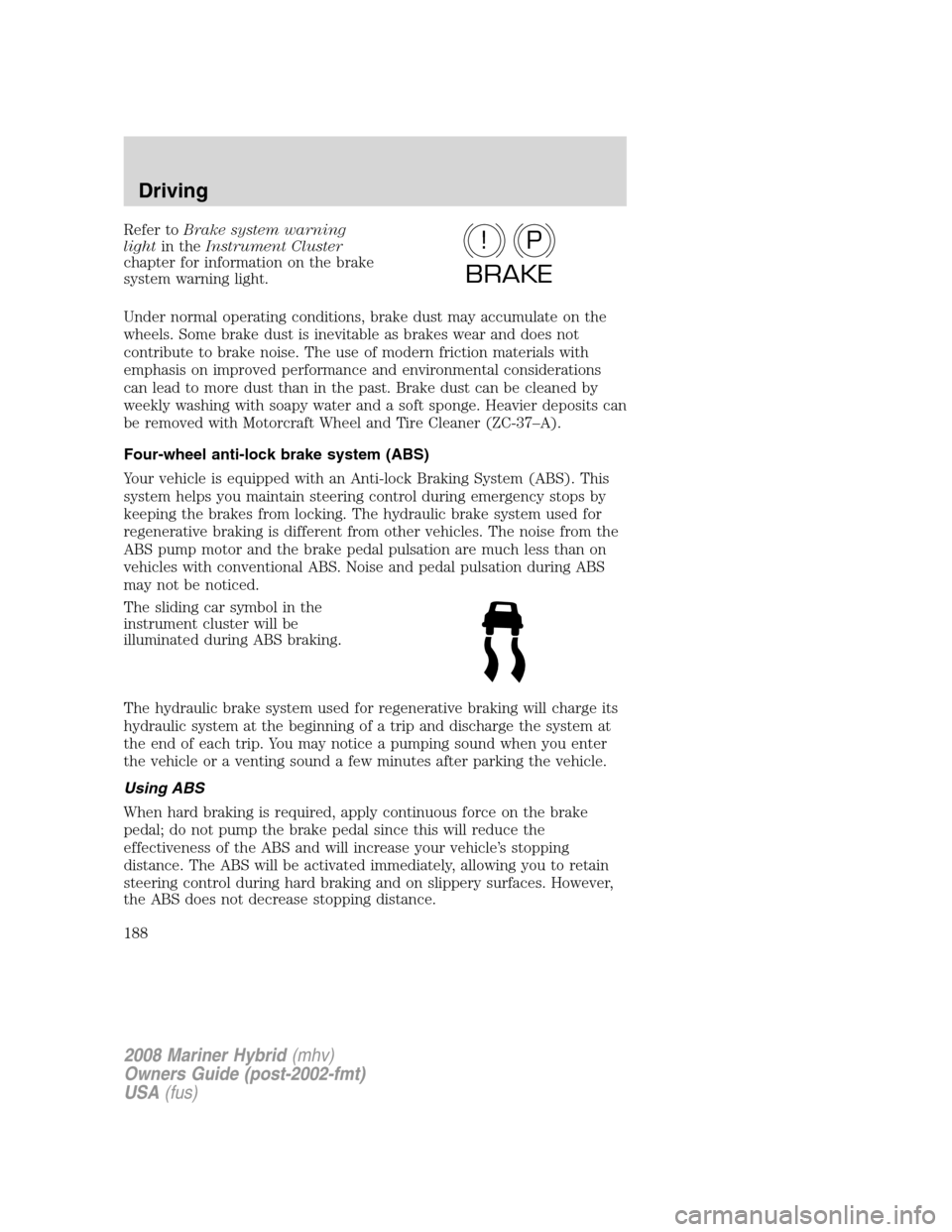
Refer toBrake system warning
lightin theInstrument Cluster
chapter for information on the brake
system warning light.
Under normal operating conditions, brake dust may accumulate on the
wheels. Some brake dust is inevitable as brakes wear and does not
contribute to brake noise. The use of modern friction materials with
emphasis on improved performance and environmental considerations
can lead to more dust than in the past. Brake dust can be cleaned by
weekly washing with soapy water and a soft sponge. Heavier deposits can
be removed with Motorcraft Wheel and Tire Cleaner (ZC-37–A).
Four-wheel anti-lock brake system (ABS)
Your vehicle is equipped with an Anti-lock Braking System (ABS). This
system helps you maintain steering control during emergency stops by
keeping the brakes from locking. The hydraulic brake system used for
regenerative braking is different from other vehicles. The noise from the
ABS pump motor and the brake pedal pulsation are much less than on
vehicles with conventional ABS. Noise and pedal pulsation during ABS
may not be noticed.
The sliding car symbol in the
instrument cluster will be
illuminated during ABS braking.
The hydraulic brake system used for regenerative braking will charge its
hydraulic system at the beginning of a trip and discharge the system at
the end of each trip. You may notice a pumping sound when you enter
the vehicle or a venting sound a few minutes after parking the vehicle.
Using ABS
When hard braking is required, apply continuous force on the brake
pedal; do not pump the brake pedal since this will reduce the
effectiveness of the ABS and will increase your vehicle’s stopping
distance. The ABS will be activated immediately, allowing you to retain
steering control during hard braking and on slippery surfaces. However,
the ABS does not decrease stopping distance.P!
BRAKE
2008 Mariner Hybrid(mhv)
Owners Guide (post-2002-fmt)
USA(fus)
Driving
188
Page 189 of 320

ABS warning lamp
The ABS lamp in the instrument
cluster momentarily illuminates
when the ignition is turned on. If
the light does not illuminate during
start up, remains on or flashes, the
ABS may be disabled and may need to be serviced.
Even when the ABS is disabled,
normal braking is still effective. (If
your BRAKE warning lamp
illuminates with the parking brake
released, have your brake system
serviced immediately by an authorized dealer.)
Regenerative Braking System (RBS)
Your vehicle uses a feature known as regenerative braking. This is used
to simulate the engine braking of an internal combustion engine and
assist the standard brake system while recovering some of the energy of
motion back into the battery to improve fuel economy. The standard
brake system is designed to fully stop the car if regenerative braking is
not available. During regenerative braking, the motor is spun as a
generator to create electrical current. This recharges the high voltage
battery and slows the vehicle. In effect, once the accelerator pedal is
released, the motor changes from an energy user to an energy producer.
When the accelerator pedal is released or the brake pedal is applied, the
brake controller automatically detects the amount of deceleration
requested and optimizes how much of the deceleration will be produced
by regenerative braking. The remaining portion is generated by standard
friction braking. When the battery is almost fully charged, the amount of
regenerative braking is limited to avoid overcharging, and the requested
deceleration is produced by standard friction braking alone.
Regenerative braking does not take the place of the standard friction
brakes; it only assists them. Regenerative braking has also been designed
to interact with the anti-lock brake system (ABS). Regenerative braking
is disabled when the ABS is activated or the battery is fully charged.
ABS
P!
BRAKE
2008 Mariner Hybrid(mhv)
Owners Guide (post-2002-fmt)
USA(fus)
Driving
189
Page 272 of 320
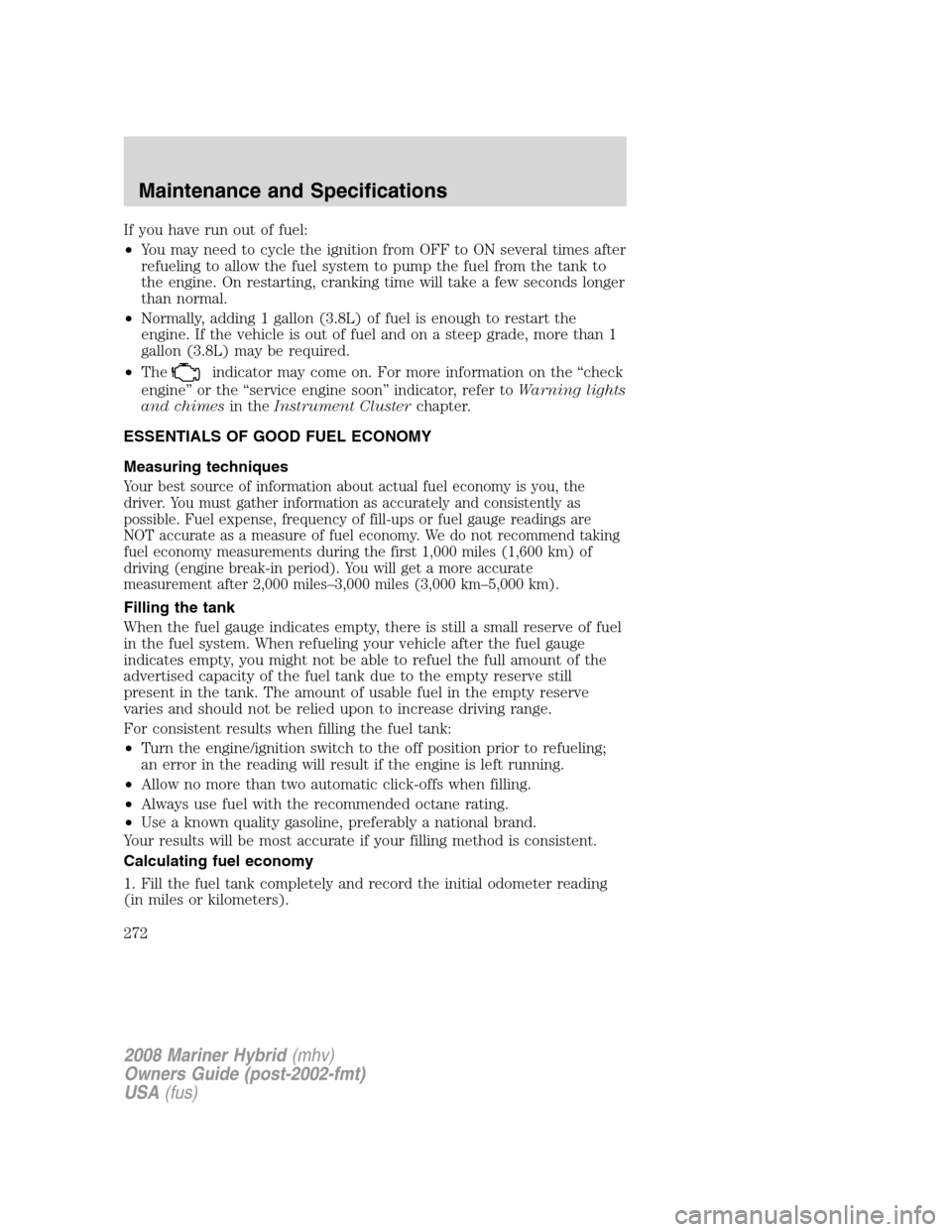
If you have run out of fuel:
•You may need to cycle the ignition from OFF to ON several times after
refueling to allow the fuel system to pump the fuel from the tank to
the engine. On restarting, cranking time will take a few seconds longer
than normal.
•Normally, adding 1 gallon (3.8L) of fuel is enough to restart the
engine. If the vehicle is out of fuel and on a steep grade, more than 1
gallon (3.8L) may be required.
•The
indicator may come on. For more information on the “check
engine” or the “service engine soon” indicator, refer toWarning lights
and chimesin theInstrument Clusterchapter.
ESSENTIALS OF GOOD FUEL ECONOMY
Measuring techniques
Your best source of information about actual fuel economy is you, the
driver. You must gather information as accurately and consistently as
possible. Fuel expense, frequency of fill-ups or fuel gauge readings are
NOT accurate as a measure of fuel economy. We do not recommend taking
fuel economy measurements during the first 1,000 miles (1,600 km) of
driving (engine break-in period). You will get a more accurate
measurement after 2,000 miles–3,000 miles (3,000 km–5,000 km).
Filling the tank
When the fuel gauge indicates empty, there is still a small reserve of fuel
in the fuel system. When refueling your vehicle after the fuel gauge
indicates empty, you might not be able to refuel the full amount of the
advertised capacity of the fuel tank due to the empty reserve still
present in the tank. The amount of usable fuel in the empty reserve
varies and should not be relied upon to increase driving range.
For consistent results when filling the fuel tank:
•Turn the engine/ignition switch to the off position prior to refueling;
an error in the reading will result if the engine is left running.
•Allow no more than two automatic click-offs when filling.
•Always use fuel with the recommended octane rating.
•Use a known quality gasoline, preferably a national brand.
Your results will be most accurate if your filling method is consistent.
Calculating fuel economy
1. Fill the fuel tank completely and record the initial odometer reading
(in miles or kilometers).
2008 Mariner Hybrid(mhv)
Owners Guide (post-2002-fmt)
USA(fus)
Maintenance and Specifications
272
Page 275 of 320
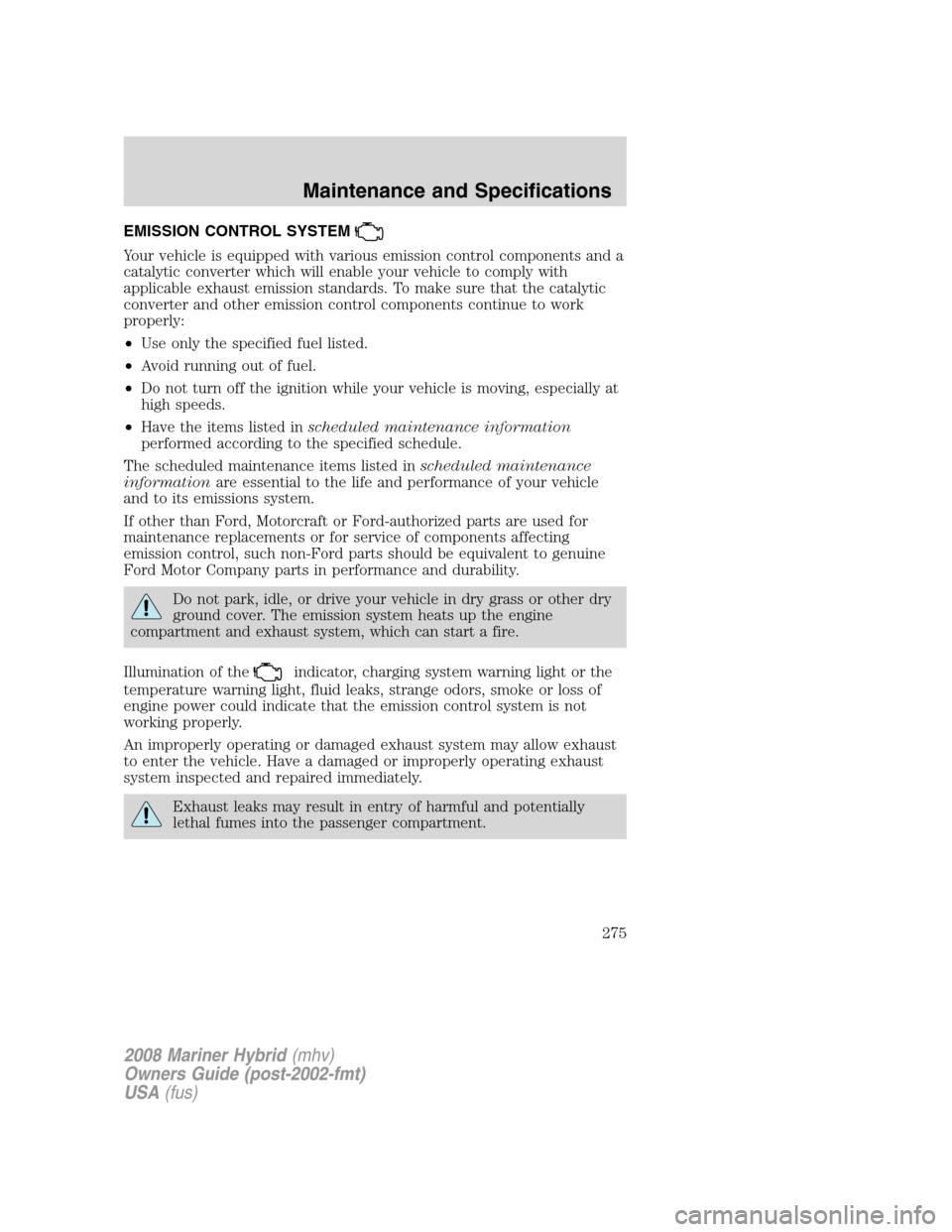
EMISSION CONTROL SYSTEM
Your vehicle is equipped with various emission control components and a
catalytic converter which will enable your vehicle to comply with
applicable exhaust emission standards. To make sure that the catalytic
converter and other emission control components continue to work
properly:
•Use only the specified fuel listed.
•Avoid running out of fuel.
•Do not turn off the ignition while your vehicle is moving, especially at
high speeds.
•Have the items listed inscheduled maintenance information
performed according to the specified schedule.
The scheduled maintenance items listed inscheduled maintenance
informationare essential to the life and performance of your vehicle
and to its emissions system.
If other than Ford, Motorcraft or Ford-authorized parts are used for
maintenance replacements or for service of components affecting
emission control, such non-Ford parts should be equivalent to genuine
Ford Motor Company parts in performance and durability.
Do not park, idle, or drive your vehicle in dry grass or other dry
ground cover. The emission system heats up the engine
compartment and exhaust system, which can start a fire.
Illumination of the
indicator, charging system warning light or the
temperature warning light, fluid leaks, strange odors, smoke or loss of
engine power could indicate that the emission control system is not
working properly.
An improperly operating or damaged exhaust system may allow exhaust
to enter the vehicle. Have a damaged or improperly operating exhaust
system inspected and repaired immediately.
Exhaust leaks may result in entry of harmful and potentially
lethal fumes into the passenger compartment.
2008 Mariner Hybrid(mhv)
Owners Guide (post-2002-fmt)
USA(fus)
Maintenance and Specifications
275
Page 278 of 320
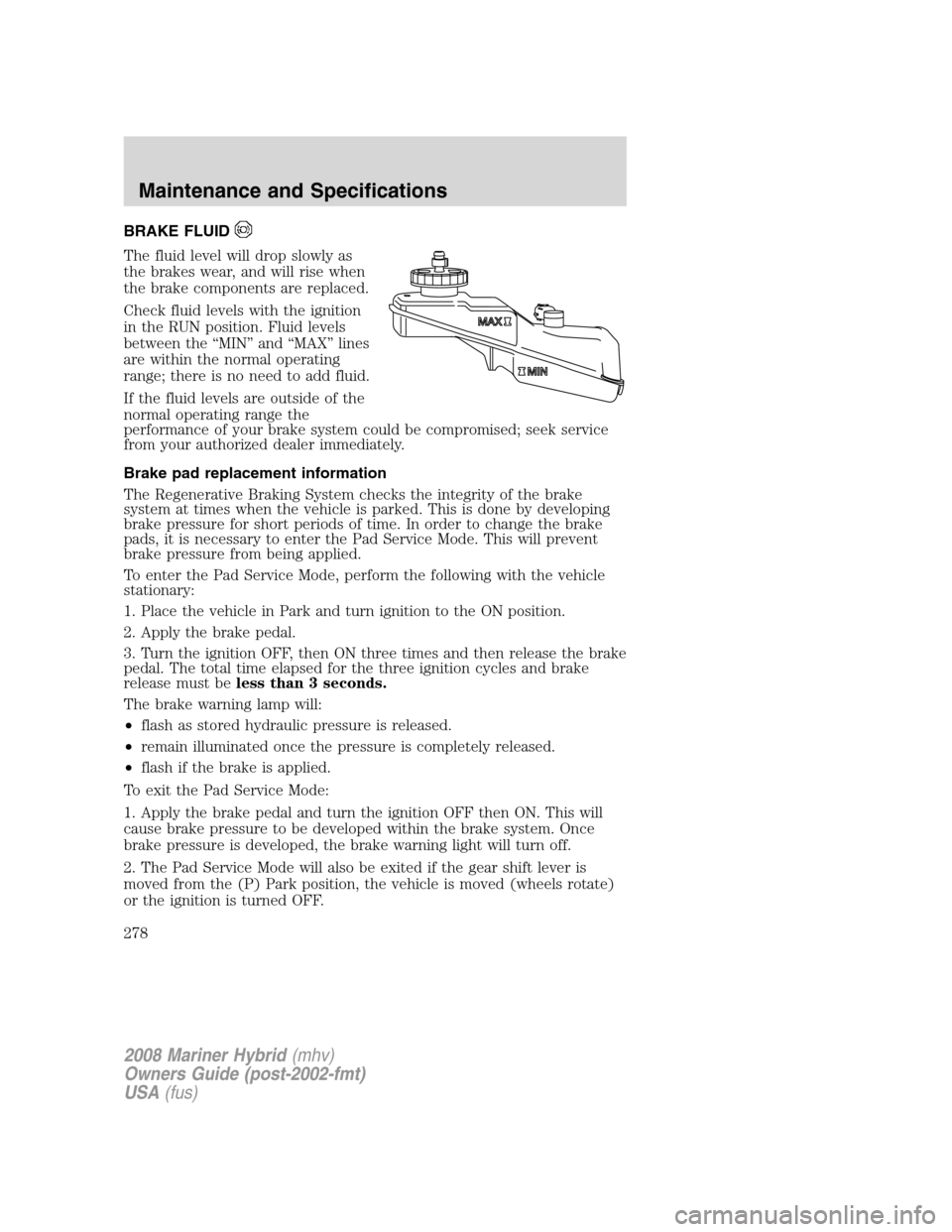
BRAKE FLUID
The fluid level will drop slowly as
the brakes wear, and will rise when
the brake components are replaced.
Check fluid levels with the ignition
in the RUN position. Fluid levels
between the “MIN” and “MAX” lines
are within the normal operating
range; there is no need to add fluid.
If the fluid levels are outside of the
normal operating range the
performance of your brake system could be compromised; seek service
from your authorized dealer immediately.
Brake pad replacement information
The Regenerative Braking System checks the integrity of the brake
system at times when the vehicle is parked. This is done by developing
brake pressure for short periods of time. In order to change the brake
pads, it is necessary to enter the Pad Service Mode. This will prevent
brake pressure from being applied.
To enter the Pad Service Mode, perform the following with the vehicle
stationary:
1. Place the vehicle in Park and turn ignition to the ON position.
2. Apply the brake pedal.
3. Turn the ignition OFF, then ON three times and then release the brake
pedal. The total time elapsed for the three ignition cycles and brake
release must beless than 3 seconds.
The brake warning lamp will:
•flash as stored hydraulic pressure is released.
•remain illuminated once the pressure is completely released.
•flash if the brake is applied.
To exit the Pad Service Mode:
1. Apply the brake pedal and turn the ignition OFF then ON. This will
cause brake pressure to be developed within the brake system. Once
brake pressure is developed, the brake warning light will turn off.
2. The Pad Service Mode will also be exited if the gear shift lever is
moved from the (P) Park position, the vehicle is moved (wheels rotate)
or the ignition is turned OFF.
MAX
MIN
2008 Mariner Hybrid(mhv)
Owners Guide (post-2002-fmt)
USA(fus)
Maintenance and Specifications
278
Page 296 of 320
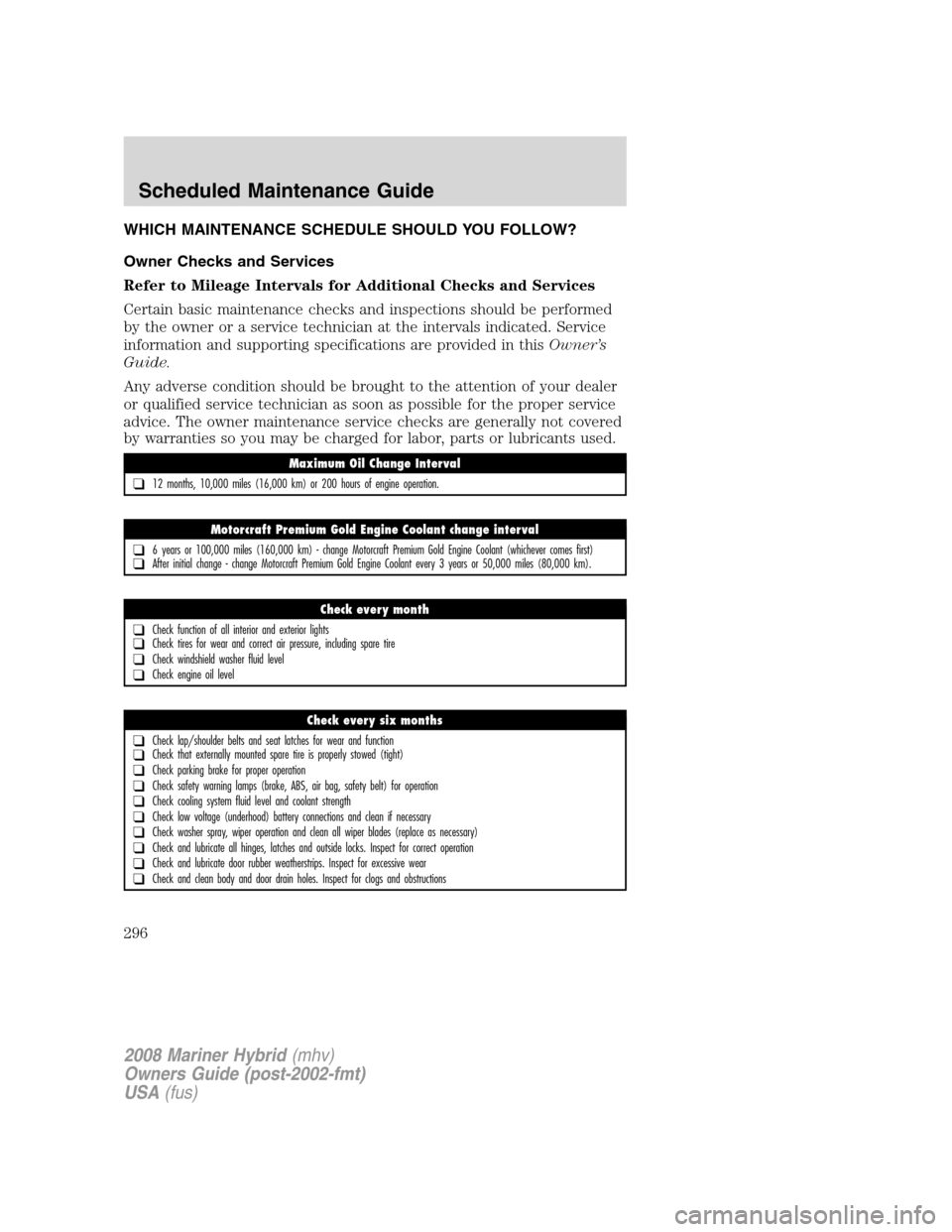
WHICH MAINTENANCE SCHEDULE SHOULD YOU FOLLOW?
Owner Checks and Services
Refer to Mileage Intervals for Additional Checks and Services
Certain basic maintenance checks and inspections should be performed
by the owner or a service technician at the intervals indicated. Service
information and supporting specifications are provided in thisOwner’s
Guide.
Any adverse condition should be brought to the attention of your dealer
or qualified service technician as soon as possible for the proper service
advice. The owner maintenance service checks are generally not covered
by warranties so you may be charged for labor, parts or lubricants used.
Maximum Oil Change Interval
❑12 months, 10,000 miles (16,000 km) or 200 hours of engine operation.
Motorcraft Premium Gold Engine Coolant change interval
❑6 years or 100,000 miles (160,000 km) - change Motorcraft Premium Gold Engine Coolant (whichever comes first)❑After initial change - change Motorcraft Premium Gold Engine Coolant every 3 years or 50,000 miles (80,000 km).
Check every month
❑Check function of all interior and exterior lights❑Check tires for wear and correct air pressure, including spare tire
❑Check windshield washer fluid level
❑Check engine oil level
Check every six months
❑Check lap/shoulder belts and seat latches for wear and function❑Check that externally mounted spare tire is properly stowed (tight)
❑Check parking brake for proper operation
❑Check safety warning lamps (brake, ABS, air bag, safety belt) for operation
❑Check cooling system fluid level and coolant strength
❑Check low voltage (underhood) battery connections and clean if necessary
❑Check washer spray, wiper operation and clean all wiper blades (replace as necessary)
❑Check and lubricate all hinges, latches and outside locks. Inspect for correct operation
❑Check and lubricate door rubber weatherstrips. Inspect for excessive wear
❑Check and clean body and door drain holes. Inspect for clogs and obstructions
2008 Mariner Hybrid(mhv)
Owners Guide (post-2002-fmt)
USA(fus)
Scheduled Maintenance Guide
296
Page 297 of 320
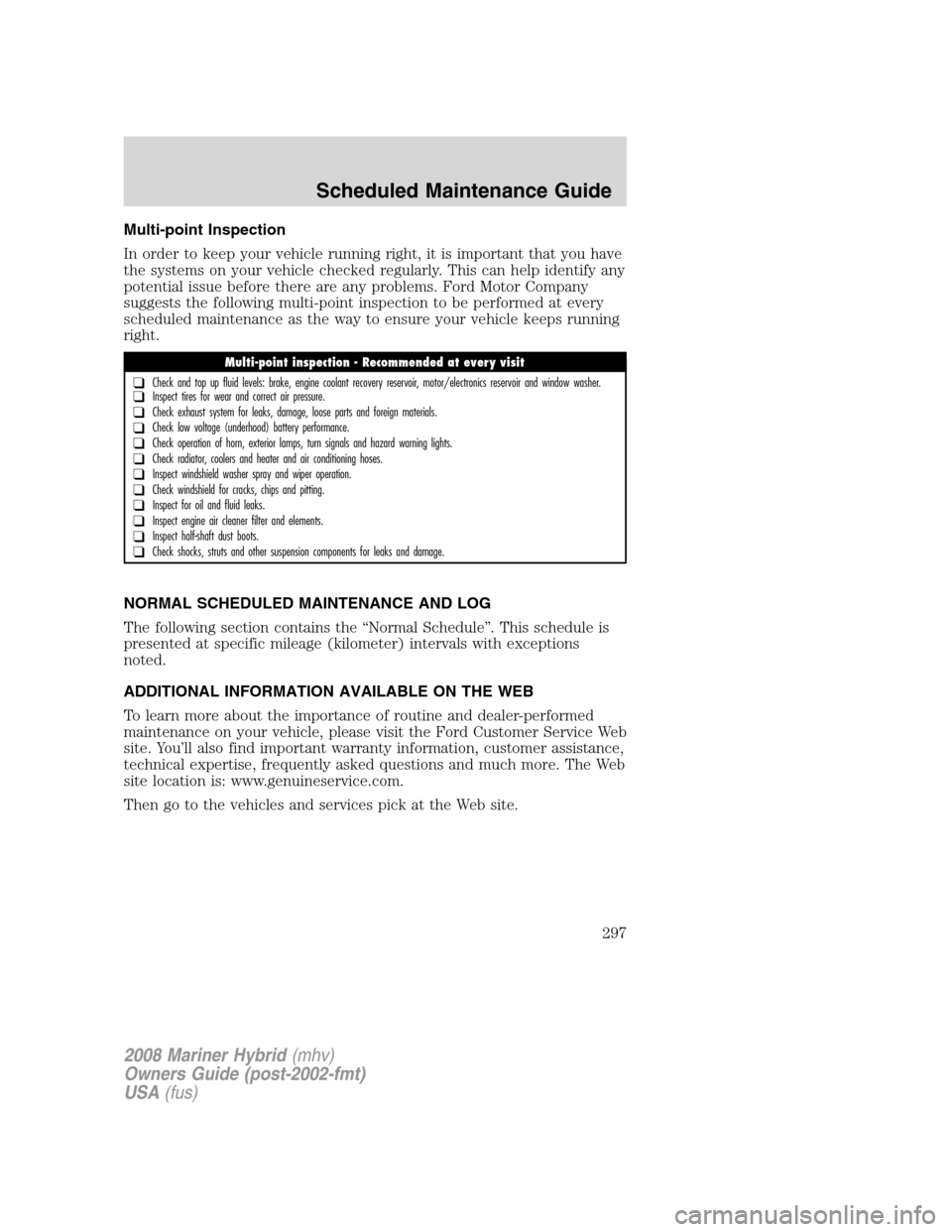
Multi-point Inspection
In order to keep your vehicle running right, it is important that you have
the systems on your vehicle checked regularly. This can help identify any
potential issue before there are any problems. Ford Motor Company
suggests the following multi-point inspection to be performed at every
scheduled maintenance as the way to ensure your vehicle keeps running
right.
NORMAL SCHEDULED MAINTENANCE AND LOG
The following section contains the “Normal Schedule”. This schedule is
presented at specific mileage (kilometer) intervals with exceptions
noted.
ADDITIONAL INFORMATION AVAILABLE ON THE WEB
To learn more about the importance of routine and dealer-performed
maintenance on your vehicle, please visit the Ford Customer Service Web
site. You’ll also find important warranty information, customer assistance,
technical expertise, frequently asked questions and much more. The Web
site location is: www.genuineservice.com.
Then go to the vehicles and services pick at the Web site.
Multi-point inspection - Recommended at every visit
❑Check and top up fluid levels: brake, engine coolant recovery reservoir, motor/electronics reservoir and window washer.❑Inspect tires for wear and correct air pressure.
❑Check exhaust system for leaks, damage, loose parts and foreign materials.
❑Check low voltage (underhood) battery performance.
❑Check operation of horn, exterior lamps, turn signals and hazard warning lights.
❑Check radiator, coolers and heater and air conditioning hoses.
❑Inspect windshield washer spray and wiper operation.
❑Check windshield for cracks, chips and pitting.
❑Inspect for oil and fluid leaks.
❑Inspect engine air cleaner filter and elements.
❑Inspect half-shaft dust boots.
❑Check shocks, struts and other suspension components for leaks and damage.
2008 Mariner Hybrid(mhv)
Owners Guide (post-2002-fmt)
USA(fus)
Scheduled Maintenance Guide
297